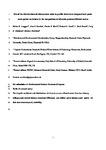Use of the distributions of adamantane acids to profile short-term temporal and pond-scale spatial variations in the composition of oil sands process-affected waters
| dc.contributor.author | Lengger, Sabine | |
| dc.contributor.author | Scarlett, AG | |
| dc.contributor.author | West, CE | |
| dc.contributor.author | Frank, RA | |
| dc.contributor.author | Hewitt, LM | |
| dc.contributor.author | Milestone, CB | |
| dc.contributor.author | Rowland, Steven | |
| dc.date.accessioned | 2015-11-09T12:52:52Z | |
| dc.date.accessioned | 2016-05-19T15:08:45Z | |
| dc.date.available | 2015-11-09T12:52:52Z | |
| dc.date.issued | 2015-07-06 | |
| dc.identifier.issn | 2050-7895 | |
| dc.identifier.issn | 2050-7895 | |
| dc.identifier.uri | http://hdl.handle.net/10026.1/4688 | |
| dc.description.abstract |
Oil industry produced waters, such as the oils sands process-affected waters (OSPW) of Alberta, Canada, represent a challenge in terms of risk assessment and reclamation due to their extreme complexity, particularly of the organic chemical constituents, including the naphthenic acids (NA). The identification of numerous NA in single samples has raised promise for the use of NA distributions for profiling OSPW. However, monitoring of the success of containment is still difficult, due to the lack of knowledge of the homogeneity (or otherwise) of OSPW composition within, and between, different industry containments. Here we used GC×GC-MS to compare the NA of five OSPW samples from each of two different industries. Short-term temporal and pond-scale spatial variations in the distributions of known adamantane acids and diacids and other unknown tricyclic acids were examined and a statistical appraisal of the replicate data made. The presence/absence of individual acids easily distinguished the OSPW NA of one industry from those of the other. The proportions of tricyclic acids with different carbon numbers also varied significantly between the OSPW of the two industries. The pond-scale spatial variation in NA in OSPW samples was higher than the short-term (2 weeks) temporal variations. An OSPW sample from an aged pond was exceptionally high in the proportion of C15,16,17 compounds, possibly due to increased biotransformation. Such techniques could possibly also help to distinguish different sources of NA in the environment. | |
| dc.format.extent | 1415-1423 | |
| dc.format.medium | Print-Electronic | |
| dc.language | en | |
| dc.language.iso | en | |
| dc.publisher | Royal Society of Chemistry | |
| dc.relation.replaces | http://hdl.handle.net/10026.1/3773 | |
| dc.relation.replaces | 10026.1/3773 | |
| dc.subject | Adamantane | |
| dc.subject | Canada | |
| dc.subject | Environmental Monitoring | |
| dc.subject | Oil and Gas Fields | |
| dc.subject | Ponds | |
| dc.subject | Water Pollutants, Chemical | |
| dc.title | Use of the distributions of adamantane acids to profile short-term temporal and pond-scale spatial variations in the composition of oil sands process-affected waters | |
| dc.type | journal-article | |
| dc.type | Article | |
| plymouth.author-url | http://gateway.webofknowledge.com/gateway/Gateway.cgi?GWVersion=2&SrcApp=PARTNER_APP&SrcAuth=LinksAMR&KeyUT=WOS:000359127800008&DestLinkType=FullRecord&DestApp=ALL_WOS&UsrCustomerID=11bb513d99f797142bcfeffcc58ea008 | |
| plymouth.issue | 8 | |
| plymouth.volume | 17 | |
| plymouth.publication-status | Published | |
| plymouth.journal | Environmental Science: Processes and Impacts | |
| dc.identifier.doi | 10.1039/c5em00287g | |
| plymouth.organisational-group | /Plymouth | |
| plymouth.organisational-group | /Plymouth/Faculty of Science and Engineering | |
| plymouth.organisational-group | /Plymouth/REF 2021 Researchers by UoA | |
| plymouth.organisational-group | /Plymouth/REF 2021 Researchers by UoA/UoA07 Earth Systems and Environmental Sciences | |
| plymouth.organisational-group | /Plymouth/Research Groups | |
| plymouth.organisational-group | /Plymouth/Research Groups/Marine Institute | |
| plymouth.organisational-group | /Plymouth/Users by role | |
| dc.publisher.place | England | |
| dcterms.dateAccepted | 2015-07-03 | |
| dc.rights.embargodate | 2017-7-7 | |
| dc.identifier.eissn | 2050-7895 | |
| dc.rights.embargoperiod | Not known | |
| rioxxterms.versionofrecord | 10.1039/c5em00287g | |
| rioxxterms.licenseref.uri | http://www.rioxx.net/licenses/all-rights-reserved | |
| rioxxterms.licenseref.startdate | 2015-07-06 | |
| rioxxterms.type | Journal Article/Review |


